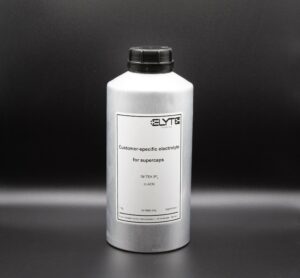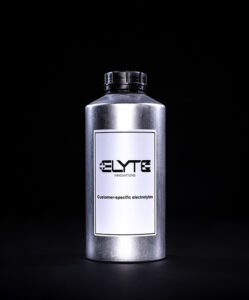
Electrolyte for supercapacitors
Specifications:
| Electrolyte salt | Tetraalkyl ammonium tetrafluoroborate salts (TEMBF4, TEABF4, TEMABF4, SBPBF4, DMPBF4, BMPBF4) Plus appropriate co-salts depending on the application. |
| Solvent | ACN (Acetonitrile), PC (Propylene carbonate), EC, BC Solvent type and composition is discussable upon application. |
| Example composition |
1.5 M TEABF4 dissolved in PC:ACN (1:3 v:v) |
| Batch sizes manufactory |
25 mL – 2.0 L bottles |
| Batch sizes production site | 20 L – 200 L barrels |
| Delivery time | maximum 14 days within EU Delivery times outside the EU on request. |
Packaging of our Electrolytes
| 20 L barrel | 200 L barrel | |
|---|---|---|
| Diameter [mm] | <=320 | <=600 |
| Height [mm] | <=530 | <=1150 |
| Net weight [kg] | ~8,5 | ~50 |
| Material (AISI) | 304 / 316L stainless steel | 304 / 316L stainless steel |
| Quick couplings | Nitto Kohki 1P for inert gas Nitto Kohki 2P for product Alternative couplings on request |
Nitto Kohki 2P for inert gas Nitto Kohki 4P for product Alternative couplings on request |
Drums per:
|
7 drums per pallet 12 drums per pallet 12 drums per pallet |
2 drums per pallet 3 drums per pallet 4 drums per pallet |
| Bottle (25 mL – 2.5 L) | Our electrolytes come in UN-certified aluminum bottles (made in Germany), which are wrapped in pouch bags sealed under an inert gas atmosphere. |
| Pouch bags | Shipped in UN-approved cardboard boxes suitable for the transportation of dangerous goods (in compliance with ADR). |
Elektrolytes for supercapacitors
Characteristics
Batteries and supercapacitors, or electric double layer capacitors (EDLCs) are often used complementarily due to their individual merits regarding energy density (batteries) and high power density (supercapacitors).
The energy storage mechanism of supercapacitors is based on the formation of double layers rather than via redox reactions (as in batteries). Since the double-layer formation occurs in seconds; supercapacitors can be charged/discharged very quickly in seconds, enabling high power. Their extended cycle life (>500,000 cycles) originates from the high reversibility of the physical storage process.
The double-layer formation takes place at the electrode/electrolyte interface, which requires tailoring of both the active material and the electrolyte. High surface area activated carbons are typically applied as active material for the positive and negative electrodes to form a large electrode/electrolyte interface. During the energy storage process, the electrolyte ions are attracted and adsorbed to the electrodes with the opposite charge. The operating voltage of is limited by the electrochemical stability of the supercapacitor components, especially to that of the electrolyte. In addition to EDLCs, there are also hybrid capacitors commercially available. Hybrid capacitors possess two electrodes, one having similar characteristics to that of a lithium-ion battery (positive electrode) and one similar to that of an EDLC (negative electrode).
Application fields
The EDLC electrolytes are composed of salts and solvents that enable high ionic conductivity and low viscosity, which is crucial for the rapid formation of the double-layer. Recently, many research efforts have been made to increase the operation voltage of the supercapacitors from around 2.8 V to above 3.0 V with the aid of novel salt/solvent combinations. Due to their large electrochemical stability window, electrolytes containing ionic liquids (ILs) are promising for high voltage applications. However, ILs generally have higher viscosity and lower ionic conductivity values than that of the standard electrolytes based on ACN or PC, which is disadvantageous regarding power density in EDLCs, thereby requiring combination with other solvents to be used in EDLC applications.
